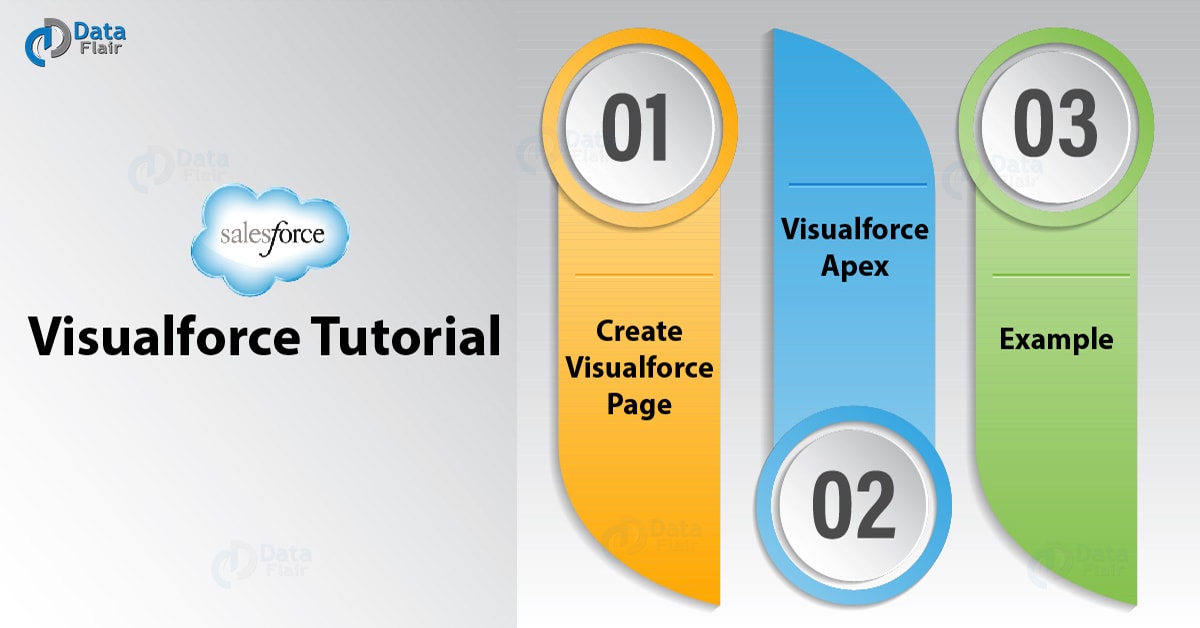Salesforce Visualforce Tutorial – Example and Apex
FREE Online Courses: Dive into Knowledge for Free. Learn More!
1. Salesforce Visualforce
Today, in this Salesforce tutorial, we are going to learn Salesforce Visualforce. Moreover, this Salesforce Visualforce Tutorial will guide us in creating a page in Salesforce. Also, we will see the MVC Model and Visualforce Apex in Salesforce.
So, let’s start the Salesforce Visualforce Tutorial.
2. What is Salesforce Visualforce?
Visualforce in Salesforce is the component-based interface framework for the Force.com platform. This framework indulges a tag-based markup language, for example, HTML. Each and every Visualforce tag corresponds to a coarse or fine-grained interface element, like a section of a page, or a field. Visualforce boasts regarding a hundred built-in elements and a mechanism whereby developers will produce their own components.
Have a look at Salesforce Schema Builder
It is guided by standard model-view-controller or we can say (MVC) paradigm, with the choice to use auto-generated controllers for database objects, providing easy and tight integration with the database. You’ll be able to write your own controllers, or extensions to controllers, using Apex Code. Visualforce provides apex components, and the formula expression language for action, data and element binding interaction.
This article introduces Visualforce. It shows us the important areas of functionality, provides an example of the MVC paradigm in action, shows the way to include information integration, and demonstrates how to produce your own components.
3. How to Create Visualforce Page in Salesforce?
A developer creates Visualforce pages by composing elements, HTML, and nonmandatory styling components on the Force.com platform. Similar to a markup language, Visualforce will integrate with any commonplace web technology or JavaScript framework to permit for an additional animated and rich interface. Every page is then accessible by a unique computer address. Once someone accesses a page, the server renders the page.
Do you know ways to export data in Salesforce
As the figure higher than illustrates, pages are created on the server and depending on the logic behind the page may move with the information, invoke external web service calls, or both, before returning the reader to the consumer (browser). In fact:
- Visualforce pages will react differently to completely different consumer browsers like those on a mobile or bit screen device.
- Optional server-side callouts may be created to any web service.
- Everything runs on the server, thus no further client-side callbacks are required to render a whole view.
4. Visualforce Apex
<apex:page standardController="Account">
<apex:form>
<apex:pageBlock title="Edit Account for {!$User.FirstName}">
<apex:pageMessages/>
<apex:pageBlockButtons>
<apex:commandButton value="Save" action="{!save}"/>
</apex:pageBlockButtons>
<apex:pageBlockSection>
<apex:inputField value="{!account.name}"/>
</apex:pageBlockSection>
</apex:pageBlock>
</apex:form>
</apex:page>- The page element covers each and every Visualforce page, additionally, its standardController attribute lets us build use of standard, automatically-generated, controller technology.
Let’s take a tour to SOSL Salesforce
- The inputField generates an acceptable input part, depending on the kind of the sphere.
- The commandButton renders a button, that once pushed, invokes a customary technique called save() on the controller.
- When you visit the page with your browser, the platform renders it, manufacturing something like the following:
There are some vital aspects of Visualforce Salesforce to the current page:
- The Account Standard Controller considers the request to look for the record id- the URL to extract a record from the information. It then makes it available to the Visualforce page.
- The $User variable provides access to details of the presently logged-in user.
- The expression retrieved the metadata related to the name field of the Account object, rendered AN acceptable input part, and initialized with the worth from the Account retrieved from the database.
- The save() technique on the controller provides a way of dogging the object back to the information. Had there not been a record within the request, this same action would try an insert of the account data provided within the type.
- Any errors that occur within the submission of the form, either standard or custom, are displayed by the pageMessages component.
- It would be easy that you will be able to produce powerful user interfaces that are tightly bound with the data, database, and controller layer is a key aspect of Visualforce. the subsequent sections examine abundant of the functionality behind Visualforce.
Do you know about Salesforce Data Security Model
So, this was all in Salesforce Visualforce. Hope you like our explanation.
5. Conclusion: Salesforce Visualforce
Hence, in this Salesforce Visualforce Tutorial, we discussed the meaning of Visualforce in Salesforce. Moreover, we discussed how to create the Visualforce page in Salesforce. Also, we saw the Visualforce apex and Visualforce pages in Salesforce Examples. Still, if you have any doubt regarding Salesforce Visualforce, ask in the comment tab.
See also –
Salesforce Navigation Setup Menu
Did you like this article? If Yes, please give DataFlair 5 Stars on Google


